 Judging by the abundance of videos and comments on them on YouTube, the topic of the so-called "Free Energy" has already snapped many and continues to excite the minds. Which is not at all surprising, because the desire to learn new things is quite natural for an intelligent person. However, not every person, having first seen something unusual and new, is able to correctly interpret what he saw. For this reason, many immediately begin to stigmatize inventors, innovators, calling them deceivers, charlatans, scammers. But is it worth judging so clearly? Let's think about it.
Judging by the abundance of videos and comments on them on YouTube, the topic of the so-called "Free Energy" has already snapped many and continues to excite the minds. Which is not at all surprising, because the desire to learn new things is quite natural for an intelligent person. However, not every person, having first seen something unusual and new, is able to correctly interpret what he saw. For this reason, many immediately begin to stigmatize inventors, innovators, calling them deceivers, charlatans, scammers. But is it worth judging so clearly? Let's think about it.
The first law of thermodynamics tells us that energy cannot be created or destroyed, it can only transfer from one species to another. This means that if the Free Energy devices, in the form in which they are presented on YouTube, are real, then they simply transform the energy of some unusual sources ...
How to measure battery capacity and convert farads to amp hours
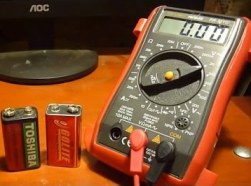 The charge Q, as the amount of electricity, is measured in coulomb (C), the electric capacity of the capacitors C is in farads, microfarads (microfarads), but the battery capacity is measured for some reason not in farads, but in ampere-hours (milliampere-hours). What would that mean? One ampere is a pendant in one second, we know from the course of physics that if an electric charge equal to 1 pendant passes through a conductor in 1 second, then a current of 1 ampere flows through the conductor.
The charge Q, as the amount of electricity, is measured in coulomb (C), the electric capacity of the capacitors C is in farads, microfarads (microfarads), but the battery capacity is measured for some reason not in farads, but in ampere-hours (milliampere-hours). What would that mean? One ampere is a pendant in one second, we know from the course of physics that if an electric charge equal to 1 pendant passes through a conductor in 1 second, then a current of 1 ampere flows through the conductor.
And then what is ampere hour? An ampere-hour (Ah) is considered to be the battery capacity at which, according to a given current of 1 ampere, the battery is discharged 1 hour before the minimum allowable voltage. For example, for a lithium-ion battery of size 18650, with a capacity of 3400 mAh, this means that the battery at a current of 340 mA can give its charge in 10 hours, and a car battery with a capacity of 55 Ah is discharged from about 12.8 to 10.8 voltsin 2 hours at a discharge current of 27.5 A ...
How to drill a wall outlet for a wall outlet
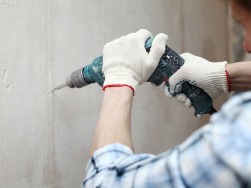 Work as an electrician is not always assembling and repairing circuits and laying cables. To lay a line, install sockets, hang fixtures, you need to properly make holes or hollow out a recess. To do this, you need to know the main types of drills and the features of their use. In this article, we will look at how to drill a hole in concrete, wooden walls and metal surfaces.
Work as an electrician is not always assembling and repairing circuits and laying cables. To lay a line, install sockets, hang fixtures, you need to properly make holes or hollow out a recess. To do this, you need to know the main types of drills and the features of their use. In this article, we will look at how to drill a hole in concrete, wooden walls and metal surfaces.
In everyday life, for basic construction work, use screwdrivers, drills, impact drills and perforators. A screwdriver is a small device designed to wrap screws and self-tapping screws in non-solid materials. They are also suitable for drilling drywall chipboard, plywood, wood and its other derivatives. Suitable for drilling not too thick metal. They are wireless and wired. The characteristics of cordless screwdrivers usually indicate not the power, but the battery voltage ...
Laying the cable through the air in the country
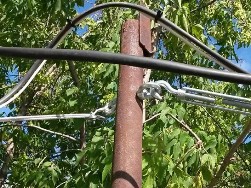 Summer residents who ennoble their site, have to deal with the need to lay wires to connect lamps in the yard, electrify workshops, garages and sheds. The line can be laid underground, but then you need to dig trenches, use expensive armored cables, PND-corrugation and so on for laying. As a result, the volume and cost of the work are quite large. Another option is to lay the line through the air. In this article we will tell you how to lay a wire through the air in the country or in a country house.
Summer residents who ennoble their site, have to deal with the need to lay wires to connect lamps in the yard, electrify workshops, garages and sheds. The line can be laid underground, but then you need to dig trenches, use expensive armored cables, PND-corrugation and so on for laying. As a result, the volume and cost of the work are quite large. Another option is to lay the line through the air. In this article we will tell you how to lay a wire through the air in the country or in a country house.
To conduct light and install sockets in utility rooms in a summer cottage or in the courtyard of a private house, you need to decide how to lay the cable.We will make a reservation that any building can be in the role of an outbuilding - a barn, a workshop, a garage and a bathhouse. There are three options: laying along the fence and walls, underground cable entry into the building, and laying the cable through the air ...
Methods for connecting electrical energy receivers
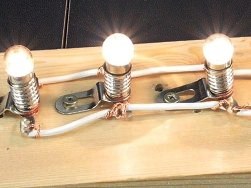 With the simultaneous inclusion of several power receivers in the same network, these receivers can easily be considered simply as elements of a single circuit, each of which has its own resistance. In some cases, this approach turns out to be quite acceptable: incandescent lamps, electric heaters, etc. - can be perceived as resistors. That is, the devices can be replaced by their resistance, and it is easy to calculate the parameters of the circuit.
With the simultaneous inclusion of several power receivers in the same network, these receivers can easily be considered simply as elements of a single circuit, each of which has its own resistance. In some cases, this approach turns out to be quite acceptable: incandescent lamps, electric heaters, etc. - can be perceived as resistors. That is, the devices can be replaced by their resistance, and it is easy to calculate the parameters of the circuit.
The method of connecting the power receivers can be one of the following: serial, parallel or mixed type of connection. When several receivers (resistors) are connected in a serial circuit, that is, the second terminal of the first is connected to the first terminal of the second, the second terminal of the second is connected to the first terminal of the third, the second terminal of the third and the first terminal of the fourth, etc., when this circuit is connected. ..
How are devices for measuring resistance arranged and working
 By their physical nature, all substances react differently to the flow of electric current through them. Some bodies pass it well and they are referred to as conductors, while others are very bad. These are dielectrics. The properties of substances to counteract the flow of current are estimated by numerical expression - the value of electrical resistance.
By their physical nature, all substances react differently to the flow of electric current through them. Some bodies pass it well and they are referred to as conductors, while others are very bad. These are dielectrics. The properties of substances to counteract the flow of current are estimated by numerical expression - the value of electrical resistance.
The principle of its definition was proposed by Georg Om. The unit of measure for this characteristic is named after him. The relationship between the electrical resistance of a substance, the voltage applied to it, and the flowing electric current is called Ohm's law. Based on the dependence of the three most important characteristics of electricity shown in the picture, the resistance value is determined. To do this, you must have: an energy source, for example, a battery or accumulator, measuring instruments for current and voltage. The voltage source is connected through an ammeter ...
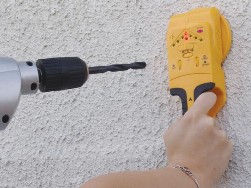 If you started a serious repair, then it is unlikely to do without drilling holes in the walls, without driving nails, without tightening the screws. But what about hidden wiring, which can accidentally fall under a drill, nail, screw? Drilling at random is life-threatening, but a preliminary search for wiring will make work safer.
If you started a serious repair, then it is unlikely to do without drilling holes in the walls, without driving nails, without tightening the screws. But what about hidden wiring, which can accidentally fall under a drill, nail, screw? Drilling at random is life-threatening, but a preliminary search for wiring will make work safer.
In the search for hidden wiring, a hidden wiring detector will help you, just select the appropriate device in the store. Fortunately, today's stores of construction and household goods offer a wide range of compact, easy-to-use detectors of this kind, differing only in functionality, principle of operation and price tag. There are cheaper partitions, there are more expensive ones, but first things first. By the principle of operation, hidden wiring detectors are divided into: electrostatic, electromagnetic, metal-detector and combined ...
How to determine the rotation speed of an electric motor
 The speed of rotation of an induction motor is usually understood as the angular frequency of rotation of its rotor, which is given on the nameplate (on the nameplate of the motor) as the number of revolutions per minute. A three-phase motor can be powered from a single-phase network, for this it is enough to add a capacitor parallel to one or two of its windings, depending on the mains voltage, but the motor design will not change from this.
The speed of rotation of an induction motor is usually understood as the angular frequency of rotation of its rotor, which is given on the nameplate (on the nameplate of the motor) as the number of revolutions per minute. A three-phase motor can be powered from a single-phase network, for this it is enough to add a capacitor parallel to one or two of its windings, depending on the mains voltage, but the motor design will not change from this.
So, if the rotor under load makes 2760 revolutions per minute, then the angular frequency of this engine will be 2760 * 2pi / 60 radians per second, that is, 289 rad / s, which is not convenient for perception, therefore they simply write “2760 rev / min. " As applied to an induction motor, these are revolutions taking into account slip s. The synchronous speed of this engine (excluding slip) will be equal to 3000 rpm, since when supplying stator windings with mains current...
